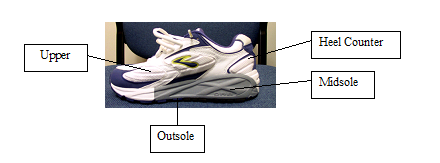Injuries Related to Shoe Break-Down
Posted by JB Smith, Co-Owner on

The shoe is an integral part of exercise and sport activity. Often when a new exercise program is started, age of the athletic shoe is neglected. Many believe that just because they haven’t used the shoe many times that it does not break down. Even those who exercise regularly often neglect their shoe gear and can sustain injuries because of it. Injuries such as plantar fasciitis, shin splints, knee pain, peroneal and Achilles tendonitis can be related to shoe-wear or break-down.
In order to examine injuries specifically related to particular shoe pattern break-down, it is imperative that basic shoe anatomy is understood. In the interest of simplicity, there are four basic parts to an athletic shoe: The Outsole, midsole, sockliner, upper and heel-counter(see Fig. 1 below, sockliner is the standard insole that comes with the shoes).
The outsole is usually made of a carbon rubber which is stiff and very durable or some shoe companies use Polyurethane (PU) which is cushioning as well as durable. Its primary function is to provide traction and stiffness so as to give the shoe some life. If the outsole wears down on the inside (medial) of the foot, this could lead to common pronation foot problems such as : plantar fasciitis, posterior tibial tendonitis, Achilles tendonitis, Shin splints, knee pain in the form of patellar maltracking or Illiobitial band syndrome. If it were to wear down on the outside (lateral) of the foot, this could lead to Peroneal tendonitis, predispose to inversion ankle sprains and lateral column foot pain.
The midsole is usually made of EVA ( Ethyl-Vinyl-Acetate). This is a type of compressed foam. It comes in varying densities which factor into the shoes’ capability of providing any pronation control. It’s main function is to provide cushioning or shock absorption. This can be modified with Air bladders (Nike), gel pads, dual density durometer EVA for motion control and/or polypropylene for more rigidity. Most motion control or stability shoes will have dual density durometer EVA ( this is usually indicated by a combined grey and white midsole, with the grey being in the medial aspect of the midsole). This is essentially the component of a shoe that would break down the fastest even with non-use. The EVA has a “shelf-life” of one year. Regardless of how many times you use the shoe, the EVA will stiffen or lose its shock absorption properties after one year. It is because of this property, the shoes should be replaced after 1 year or 500 miles. It essentially becomes stiffer. If the midsole wears down medially or laterally it can cause similar problems as outlined above with regard to the outsole breakdown. With the stiffness, the most common concern would be joint pain in the ankles and knees along with the risk of stress fractures to the foot and shin or leg bones. It is important to note that after each use, the EVA needs 36 hours of recovery time to regain its shape. It would be adviseable to have two pairs of shoes if exercise was done daily and alternate each use.
The upper is usually made of a combination of nylon mesh and synthetic leather. It functions to provide added support adhering the foot to the midsole/outsole as well as breathability and perspiration control. If the upper breaks down and gets stretched out, it loses the capability of providing foot control. The foot will tend to move around too much inside the shoe thus possibly causing blisters.
The heel counter portion of the upper provide heel motion control. This is usually made of polypropylene in good shoes, otherwise it is just made of a synthetic leather. It needs to be stiffer for better heel control. If this is too soft or breaksdown, the foot will have more motion and can cause blisters or, in a pronated foot, cause plantar fasciitis or Achilles tendonitis.
The sockliner is usually made of foam, polyurethane or felt depending on shoe quality. Its purpose is to provide added cushioning as well as moisture absorption. Most athletic shoes have removable sockliners to allow for replacement with custom or pre-made orthotics. Most sockliners will last the life of the shoe (one year or 500 miles). If it does breakdown, blisters would be the main issue along with shock absorption and thus the potential for stress fractures in the lower extremities increases.
These are generalizations with regard to shoe wear and potential injuries. It is important to note that finding the right shoe for each foot type and activity is paramount along with consideration of biomechanical foot and leg abnormalities. If you are unsure as to what shoe would be best for you, consult your Sports Podiatrist. The shoefitters in our Bellevue location can also help you find the perfect shoe.
